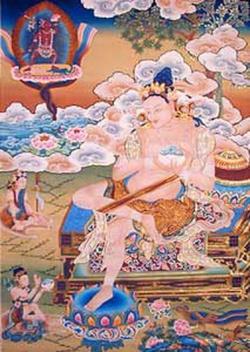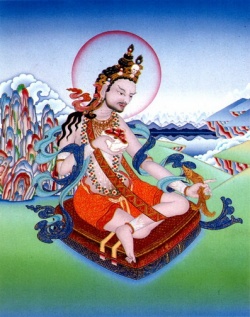Mahasiddha Sri Naropa
Naropa was born into a noble family of Pullahari, in Kashmir, in 1016 AD. We are told that he was originally named Samantabhadra. He was raised as an aristocrat, with the intention that he would inherit the position of his father as a major ruler and leader of the people. However, by the age of eight his inclination was towards religion. He began to explore the field of learning and became a noted young scholar. Then, according to the well established customs of India, his parents arranged a marriage for him with a lovely Brahmin girl named Vimaladipe. Although the couple were happy together, Naropa's inner desire to pursue a religious course more and more began to dominate their lives. Vimaladipe became his disciple in this pursuit.
According to the story of Naropa's life, he deserted home and went to the main monastery of Kashmir for ordination. There he was ordained as a novice monk (sramanera) in the Sarvastivada order of Buddhism and engaged himself in scholastic studies for the next three years. Kashmir, at this time in history, was famous as a place of great learning and science.
At the age of 28, now a fully ordained monk (bhikkshu), Naropa graduated to Nalanda University in the heart of India. This state-sponsored University was an extremely famous place, with a faculty of 500 professors and a vast number of students, many from as far away as Ceylon, Indonesia, or even Greece and China. In those days nobody was considered truly learned unless they had studied at Nalanda University. The curriculum consisted of a ten year course and was extremely tough.
Nalanda had four grand gate houses leading into the University, and it was the privilege of the four most learned and highly respected professors of the University each to reside in one of these special houses. With time, Naropa rose through the ranks and eventually became one of these four professors. At this time in his life he was known as Mahapandita Abhayakirti. His fame spread far and wide, and for eight years he taught at this great institution of learning.
One day, so it is said, when Naropa was sitting in the shade of a large banyan tree, studying his books, an ugly old woman come up to him. She asked him if he could understand the words which he was reading. "Yes, of course," he replied, thinking that she was just some old illiterate peasant woman. At this she cackled with laughter. Then she asked him if he experienced the meaning of what he was reading. Again, he replied, "Of course." The old hag burst into tears.
"Why do you cry?" Naropa asked. She then explained to him that first she was overjoyed when he said he could comprehend the words, but she wept when he also claimed to really know the meaning. "You, having not experienced Enlightenment, cannot possibly really know the actual meaning," she explained. "Yet, being a scholar, you mistakenly believe that intellectual comprehension equals genuine Enlightened experience." Naropa had to admit that she was correct.
"How can I realize Enlightenment," he asked. "My brother is the great yogi Tilopa," she explained, "and he can guide you on the path of direct mystical experience."
As with many tales in the lives of an initiate, the legend of Naropa describes how he went through twelve painful trials, to receive the mystical teachings of the "Way of the Yogi" from Tilopa. Each trial that Naropa had to undergo demonstrated some aspect of the teaching and also broke through Naropa's pride. Though he suffered tremendously during these trials, Naropa persevered to the end and won through to Enlightenment in only a few years. By now, Naropa had renounced the life of a monk and become a white clad yogi in Tilopa's tradition. He wandered through Bengal.
After his Enlightenment, Naropa returned to Pullahari. It is said that his former wife became a great Yogini there, while following Naropa's guidance. She is famous as the Yogini Niguma and in many treatises is referred to as Naropa's sister. A lineage of instruction has come down from her to this day.
Naropa is renowned as the teacher of the Tibetan mystic, Marpa of Lhodrak. When Marpa, as a young man, first left Tibet, he traveled over the high passes to Parphing, in Nepal. He stayed at Parphing for some time, adjusting to the climate, prior to traveling down into the hot plains of India. It was while at Parphing that he met two Yogi brothers, both disciples of Naropa. This led to Marpa eventually seeking out Naropa and becoming his disciple. This is how the Tibetan Ka'gyu lineage began.
Marpa received the full Four Transmissions of Oral Instructions of Tilopa from his guru, and also gathered further instructions in Dream Yoga and the After-death state. This has come down to us as the Six Doctrines of Naropa.
Naropa eventually passed away, resurrected into light, leaving no physical remains. His body of teachings, however, continues. Today it is the Gyalwa Karmapa who is the custodian of these precious methods whereby a person may attain Enlightenment in a single short lifetime.
Naropa, Mahasiddha: one of the principal Tantric Buddhist siddha of India. He is counted in both the Vajrasana and Abhayadatta Shri systems of enumerating the eighty-four mahasiddha. These great accomplished ones are regarded as being the original human source for most if not all of the Tantric literature and practice traditions of Tantric Buddhism. Naropa figures prominently in many lineages of tantric practice - especially honoured in the early Marpa Kagyu lineage of teachers.
The Tibetan Marpa Chokyi Lodro (1012-1099), founder of the Marpa Kagyu Tradition, having journeyed three times to India, studied extensively with Naropa. In the Sakya School Naropa is honoured as the originator of an important cycle of Vajrayogini practice counted as one of the very special teachings of Sakya. Lineages that include the name Naropa weave through all of the Sarma Schools of Tibetan Buddhism.

